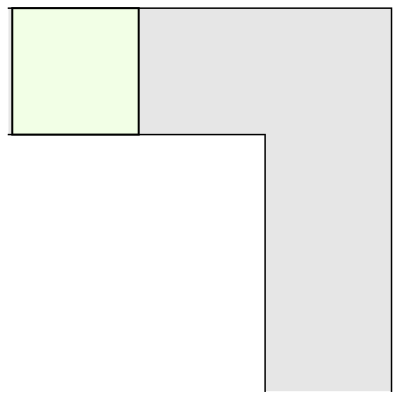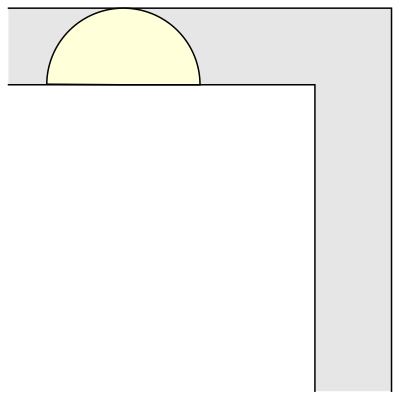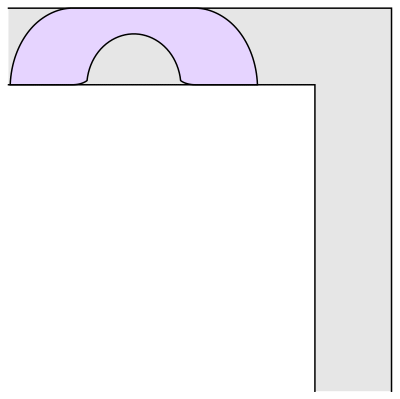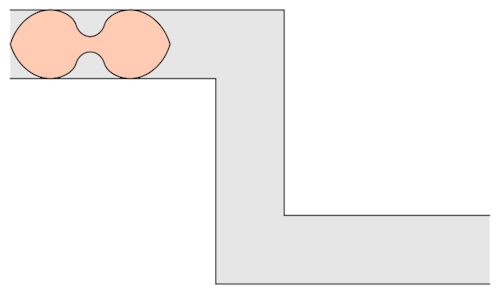I Like Old Maps. How About You?
I like old maps. How about you?

Wednesday? Map Day! A while back we shared the all the portions of this enormous 1867 map except for the southeast quadrant. So here you go!
We can only provide this massive beast in quarters because the digital map in its entirety is far too large to upload. That being said, you can find the whole thing right here.
More Posts from Artldy and Others

If one remembers this particular episode from the popular sitcom ‘Friends’ where Ross is trying to carry a sofa to his apartment, it seems that moving a sofa up the stairs is ridiculously hard.
But life shouldn’t be that hard now should it?
The mathematician Leo Moser posed in 1966 the following curious mathematical problem: what is the shape of largest area in the plane that can be moved around a right-angled corner in a two-dimensional hallway of width 1? This question became known as the moving sofa problem, and is still unsolved fifty years after it was first asked.

The most common shape to move around a tight right angled corner is a square.
And another common shape that would satisfy this criterion is a semi-circle.

But what is the largest area that can be moved around?
Well, it has been conjectured that the shape with the largest area that one can move around a corner is known as “Gerver’s sofa”. And it looks like so:

Wait.. Hang on a second
This sofa would only be effective for right handed turns. One can clearly see that if we have to turn left somewhere we would be kind of in a tough spot.
Prof.Romik from the University of California, Davis has proposed this shape popularly know as Romik’s ambidextrous sofa that solves this problem.

Although Prof.Romik’s sofa may/may not be the not the optimal solution, it is definitely is a breakthrough since this can pave the way for more complex ideas in mathematical analysis and more importantly sofa design.

Have a good one!

Fall vibes 🧡🍂 🐱 🍂🧡
10 Things: Mars Helicopter
When our next Mars rover lands on the Red Planet in 2021, it will deliver a groundbreaking technology demonstration: the first helicopter to ever fly on a planetary body other than Earth. This Mars Helicopter will demonstrate the first controlled, powered, sustained flight on another world. It could also pave the way for future missions that guide rovers and gather science data and images at locations previously inaccessible on Mars. This exciting new technology could change the way we explore Mars.

1. Its body is small, but its blades are mighty.
One of the biggest engineering challenges is getting the Mars Helicopter’s blades just right. They need to push enough air downward to receive an upward force that allows for thrust and controlled flight — a big concern on a planet where the atmosphere is only one percent as dense as Earth’s. “No helicopter has flown in those flight conditions – equivalent to 100,000 feet (30,000 meters) on Earth,” said Bob Balaram, chief engineer for the project at our Jet Propulsion Laboratory.

2. It has to fly in really thin Martian air.
To compensate for Mars’ thin atmosphere, the blades must spin much faster than on an Earth helicopter, and the blade size relative to the weight of the helicopter has to be larger too. The Mars Helicopter’s rotors measure 4 feet wide (about 1.2 meters) long, tip to tip. At 2,800 rotations per minute, it will spin about 10 times faster than an Earth helicopter. At the same time, the blades shouldn’t flap around too much, as the helicopter’s design team discovered during testing. Their solution: make the blades more rigid. “Our blades are much stiffer than any terrestrial helicopter’s would need to be,” Balaram said. The body, meanwhile, is tiny — about the size of a softball. In total, the helicopter will weigh just under 4 pounds (1.8 kilograms).

3. It will make up to five flights on Mars.
Over a 30-day period on Mars, the helicopter will attempt up to five flights, each time going farther than the last. The helicopter will fly up to 90 seconds at a time, at heights of up to 10 to 15 feet (3 to 5 meters). Engineers will learn a lot about flying a helicopter on Mars with each flight, since it’s never been done before!

4. The Mars Helicopter team has already completed groundbreaking tests.
Because a helicopter has never visited Mars before, the Mars Helicopter team has worked hard to figure out how to predict the helicopter’s performance on the Red Planet. “We had to invent how to do planetary helicopter testing on Earth,” said Joe Melko, deputy chief engineer of Mars Helicopter, based at JPL.
The team, led by JPL and including members from JPL, AeroVironment Inc., Ames Research Center, and Langley Research Center, has designed, built and tested a series of test vehicles.
In 2016, the team flew a full-scale prototype test model of the helicopter in the 25-foot (7.6-meter) space simulator at JPL. The chamber simulated the low pressure of the Martian atmosphere. More recently, in 2018, the team built a fully autonomous helicopter designed to operate on Mars, and successfully flew it in the 25-foot chamber in Mars-like atmospheric density.
Engineers have also exercised the rotors of a test helicopter in a cold chamber to simulate the low temperatures of Mars at night. In addition, they have taken design steps to deal with Mars-like radiation conditions. They have also tested the helicopter’s landing gear on Mars-like terrain. More tests are coming to see how it performs with Mars-like winds and other conditions.

5. The camera is as good as your cell phone camera.
The helicopter’s first priority is successfully flying on Mars, so engineering information takes priority. An added bonus is its camera. The Mars Helicopter has the ability to take color photos with a 13-megapixel camera — the same type commonly found in smart phones today. Engineers will attempt to take plenty of good pictures.
6. It’s battery-powered, but the battery is rechargeable.
The helicopter requires 360 watts of power for each second it hovers in the Martian atmosphere – equivalent to the power required by six regular lightbulbs. But it isn’t out of luck when its lithium-ion batteries run dry. A solar array on the helicopter will recharge the batteries, making it a self-sufficient system as long as there is adequate sunlight. Most of the energy will be used to keep the helicopter warm, since nighttime temperatures on Mars plummet to around minus 130 degrees Fahrenheit (minus 90 Celsius). During daytime flights, temperatures may rise to a much warmer minus 13 to minus 58 degrees Fahrenheit to (minus 25 to minus 50 degrees Celsius) — still chilly by Earth standards. The solar panel makes an average of 3 watts of power continuously during a 12-hour Martian day.
7. The helicopter will be carried to Mars under the belly of the rover.
Somewhere between 60 to 90 Martian days (or sols) after the Mars 2020 rover lands, the helicopter will be deployed from the underside of the rover. Mars Helicopter Delivery System on the rover will rotate the helicopter down from the rover and release it onto the ground. The rover will then drive away to a safe distance.

8. The helicopter will talk to the rover.
The Mars 2020 rover will act as a telecommunication relay, receiving commands from engineers back on Earth and relaying them to the helicopter. The helicopter will then send images and information about its own performance to the rover, which will send them back to Earth. The rover will also take measurements of wind and atmospheric data to help flight controllers on Earth.
9. It has to fly by itself, with some help.
Radio signals take time to travel to Mars — between four and 21 minutes, depending on where Earth and Mars are in their orbits — so instantaneous communication with the helicopter will be impossible. That means flight controllers can’t use a joystick to fly it in real time, like a video game. Instead, they need to send commands to the helicopter in advance, and the little flying robot will follow through. Autonomous systems will allow the helicopter to look at the ground, analyze the terrain to look how fast it’s moving, and land on its own.
10. It could pave the way for future missions.
A future Mars helicopter could scout points of interest, help scientists and engineers select new locations and plan driving routes for a rover. Larger standalone helicopters could carry science payloads to investigate multiple sites at Mars. Future helicopters could also be used to fly to places on Mars that rovers cannot reach, such as cliffs or walls of craters. They could even assist with human exploration one day. Says Balaram: “Someday, if we send astronauts, these could be the eyes of the astronauts across Mars.”
Read the full version of this week’s ‘10 Things to Know’ article on the web HERE.
Make sure to follow us on Tumblr for your regular dose of space: http://nasa.tumblr.com.
10 Things Einstein Got Right
One hundred years ago, on May 29, 1919, astronomers observed a total solar eclipse in an ambitious effort to test Albert Einstein’s general theory of relativity by seeing it in action. Essentially, Einstein thought space and time were intertwined in an infinite “fabric,” like an outstretched blanket. A massive object such as the Sun bends the spacetime blanket with its gravity, such that light no longer travels in a straight line as it passes by the Sun.
This means the apparent positions of background stars seen close to the Sun in the sky – including during a solar eclipse – should seem slightly shifted in the absence of the Sun, because the Sun’s gravity bends light. But until the eclipse experiment, no one was able to test Einstein’s theory of general relativity, as no one could see stars near the Sun in the daytime otherwise.
The world celebrated the results of this eclipse experiment— a victory for Einstein, and the dawning of a new era of our understanding of the universe.
General relativity has many important consequences for what we see in the cosmos and how we make discoveries in deep space today. The same is true for Einstein’s slightly older theory, special relativity, with its widely celebrated equation E=mc². Here are 10 things that result from Einstein’s theories of relativity:

1. Universal Speed Limit
Einstein’s famous equation E=mc² contains “c,” the speed of light in a vacuum. Although light comes in many flavors – from the rainbow of colors humans can see to the radio waves that transmit spacecraft data – Einstein said all light must obey the speed limit of 186,000 miles (300,000 kilometers) per second. So, even if two particles of light carry very different amounts of energy, they will travel at the same speed.
This has been shown experimentally in space. In 2009, our Fermi Gamma-ray Space Telescope detected two photons at virtually the same moment, with one carrying a million times more energy than the other. They both came from a high-energy region near the collision of two neutron stars about 7 billion years ago. A neutron star is the highly dense remnant of a star that has exploded. While other theories posited that space-time itself has a “foamy” texture that might slow down more energetic particles, Fermi’s observations found in favor of Einstein.

2. Strong Lensing
Just like the Sun bends the light from distant stars that pass close to it, a massive object like a galaxy distorts the light from another object that is much farther away. In some cases, this phenomenon can actually help us unveil new galaxies. We say that the closer object acts like a “lens,” acting like a telescope that reveals the more distant object. Entire clusters of galaxies can be lensed and act as lenses, too.
When the lensing object appears close enough to the more distant object in the sky, we actually see multiple images of that faraway object. In 1979, scientists first observed a double image of a quasar, a very bright object at the center of a galaxy that involves a supermassive black hole feeding off a disk of inflowing gas. These apparent copies of the distant object change in brightness if the original object is changing, but not all at once, because of how space itself is bent by the foreground object’s gravity.
Sometimes, when a distant celestial object is precisely aligned with another object, we see light bent into an “Einstein ring” or arc. In this image from our Hubble Space Telescope, the sweeping arc of light represents a distant galaxy that has been lensed, forming a “smiley face” with other galaxies.

3. Weak Lensing
When a massive object acts as a lens for a farther object, but the objects are not specially aligned with respect to our view, only one image of the distant object is projected. This happens much more often. The closer object’s gravity makes the background object look larger and more stretched than it really is. This is called “weak lensing.”
Weak lensing is very important for studying some of the biggest mysteries of the universe: dark matter and dark energy. Dark matter is an invisible material that only interacts with regular matter through gravity, and holds together entire galaxies and groups of galaxies like a cosmic glue. Dark energy behaves like the opposite of gravity, making objects recede from each other. Three upcoming observatories – Our Wide Field Infrared Survey Telescope, WFIRST, mission, the European-led Euclid space mission with NASA participation, and the ground-based Large Synoptic Survey Telescope — will be key players in this effort. By surveying distortions of weakly lensed galaxies across the universe, scientists can characterize the effects of these persistently puzzling phenomena.
Gravitational lensing in general will also enable NASA’s James Webb Space telescope to look for some of the very first stars and galaxies of the universe.

4. Microlensing
So far, we’ve been talking about giant objects acting like magnifying lenses for other giant objects. But stars can also “lens” other stars, including stars that have planets around them. When light from a background star gets “lensed” by a closer star in the foreground, there is an increase in the background star’s brightness. If that foreground star also has a planet orbiting it, then telescopes can detect an extra bump in the background star’s light, caused by the orbiting planet. This technique for finding exoplanets, which are planets around stars other than our own, is called “microlensing.”
Our Spitzer Space Telescope, in collaboration with ground-based observatories, found an “iceball” planet through microlensing. While microlensing has so far found less than 100 confirmed planets, WFIRST could find more than 1,000 new exoplanets using this technique.

5. Black Holes
The very existence of black holes, extremely dense objects from which no light can escape, is a prediction of general relativity. They represent the most extreme distortions of the fabric of space-time, and are especially famous for how their immense gravity affects light in weird ways that only Einstein’s theory could explain.
In 2019 the Event Horizon Telescope international collaboration, supported by the National Science Foundation and other partners, unveiled the first image of a black hole’s event horizon, the border that defines a black hole’s “point of no return” for nearby material. NASA’s Chandra X-ray Observatory, Nuclear Spectroscopic Telescope Array (NuSTAR), Neil Gehrels Swift Observatory, and Fermi Gamma-ray Space Telescope all looked at the same black hole in a coordinated effort, and researchers are still analyzing the results.

6. Relativistic Jets
This Spitzer image shows the galaxy Messier 87 (M87) in infrared light, which has a supermassive black hole at its center. Around the black hole is a disk of extremely hot gas, as well as two jets of material shooting out in opposite directions. One of the jets, visible on the right of the image, is pointing almost exactly toward Earth. Its enhanced brightness is due to the emission of light from particles traveling toward the observer at near the speed of light, an effect called “relativistic beaming.” By contrast, the other jet is invisible at all wavelengths because it is traveling away from the observer near the speed of light. The details of how such jets work are still mysterious, and scientists will continue studying black holes for more clues.

7. A Gravitational Vortex
Speaking of black holes, their gravity is so intense that they make infalling material “wobble” around them. Like a spoon stirring honey, where honey is the space around a black hole, the black hole’s distortion of space has a wobbling effect on material orbiting the black hole. Until recently, this was only theoretical. But in 2016, an international team of scientists using European Space Agency’s XMM-Newton and our Nuclear Spectroscopic Telescope Array (NUSTAR) announced they had observed the signature of wobbling matter for the first time. Scientists will continue studying these odd effects of black holes to further probe Einstein’s ideas firsthand.
Incidentally, this wobbling of material around a black hole is similar to how Einstein explained Mercury’s odd orbit. As the closest planet to the Sun, Mercury feels the most gravitational tug from the Sun, and so its orbit’s orientation is slowly rotating around the Sun, creating a wobble.

8. Gravitational Waves
Ripples through space-time called gravitational waves were hypothesized by Einstein about 100 years ago, but not actually observed until recently. In 2016, an international collaboration of astronomers working with the Laser Interferometer Gravitational-Wave Observatory (LIGO) detectors announced a landmark discovery: This enormous experiment detected the subtle signal of gravitational waves that had been traveling for 1.3 billion years after two black holes merged in a cataclysmic event. This opened a brand new door in an area of science called multi-messenger astronomy, in which both gravitational waves and light can be studied.
For example, our telescopes collaborated to measure light from two neutron stars merging after LIGO detected gravitational wave signals from the event, as announced in 2017. Given that gravitational waves from this event were detected mere 1.7 seconds before gamma rays from the merger, after both traveled 140 million light-years, scientists concluded Einstein was right about something else: gravitational waves and light waves travel at the same speed.

9. The Sun Delaying Radio Signals
Planetary exploration spacecraft have also shown Einstein to be right about general relativity. Because spacecraft communicate with Earth using light, in the form of radio waves, they present great opportunities to see whether the gravity of a massive object like the Sun changes light’s path.
In 1970, our Jet Propulsion Laboratory announced that Mariner VI and VII, which completed flybys of Mars in 1969, had conducted experiments using radio signals — and also agreed with Einstein. Using NASA’s Deep Space Network (DSN), the two Mariners took several hundred radio measurements for this purpose. Researchers measured the time it took for radio signals to travel from the DSN dish in Goldstone, California, to the spacecraft and back. As Einstein would have predicted, there was a delay in the total roundtrip time because of the Sun’s gravity. For Mariner VI, the maximum delay was 204 microseconds, which, while far less than a single second, aligned almost exactly with what Einstein’s theory would anticipate.
In 1979, the Viking landers performed an even more accurate experiment along these lines. Then, in 2003 a group of scientists used NASA’s Cassini Spacecraft to repeat these kinds of radio science experiments with 50 times greater precision than Viking. It’s clear that Einstein’s theory has held up!

10. Proof from Orbiting Earth
In 2004, we launched a spacecraft called Gravity Probe B specifically designed to watch Einstein’s theory play out in the orbit of Earth. The theory goes that Earth, a rotating body, should be pulling the fabric of space-time around it as it spins, in addition to distorting light with its gravity.
The spacecraft had four gyroscopes and pointed at the star IM Pegasi while orbiting Earth over the poles. In this experiment, if Einstein had been wrong, these gyroscopes would have always pointed in the same direction. But in 2011, scientists announced they had observed tiny changes in the gyroscopes’ directions as a consequence of Earth, because of its gravity, dragging space-time around it.

BONUS: Your GPS! Speaking of time delays, the GPS (global positioning system) on your phone or in your car relies on Einstein’s theories for accuracy. In order to know where you are, you need a receiver – like your phone, a ground station and a network of satellites orbiting Earth to send and receive signals. But according to general relativity, because of Earth’s gravity curving spacetime, satellites experience time moving slightly faster than on Earth. At the same time, special relativity would say time moves slower for objects that move much faster than others.
When scientists worked out the net effect of these forces, they found that the satellites’ clocks would always be a tiny bit ahead of clocks on Earth. While the difference per day is a matter of millionths of a second, that change really adds up. If GPS didn’t have relativity built into its technology, your phone would guide you miles out of your way!
Make sure to follow us on Tumblr for your regular dose of space: http://nasa.tumblr.com.










Couture Beyond, Guo Pei
The first major book on China’s leading couture visionary reveals the intricate craftsmanship and imperial glamour that has fashion publications worldwide declaring Guo Pei’s creations ‘the empire’s new clothes.’
An exponent of artisan craftsmanship and theatrical fantasy often compared to Alexander McQueen and Sarah Burton, Guo Pei dresses Chinese state dignitaries and American celebrities alike in richly bejeweled creations of imperial opulence. The designer’s first monograph, published on the occasion of her first solo exhibition, offers insight into the growing global influence of China and the complexities of its cultural transition.
#Photography on Instagram | Follow our blog for more!
So much fun...
This Guy Won’t Stop Photoshopping Himself Into Kendall Jenner’s Photos And It Makes Them 10 Times Better













Credit: Kirby Jenner / IG
via: boredpanda.com

2019 May 14
Young Star Cluster Trumpler 14 from Hubble Image Credit: NASA, ESA, and J. Maíz Apellániz (IoAoA Spain); Acknowledgment: N. Smith (U. Arizona)
Explanation: Why does star cluster Trumpler 14 have so many bright stars? Because it is so young. Many cluster stars have formed only in the past 5 million years and are so hot they emit detectable X-rays. In older star clusters, most stars this young have already died – typically exploding in a supernova – leaving behind stars that are fainter and redder. Trumpler 14 spans about 40 light years and lies about 9,000 light years away on the edge of the famous Carina Nebula. A discerning eye can spot two unusual objects in this detailed 2006 image of Trumpler 14 by the Hubble Space Telescope. First, a dark cloud just left of center may be a planetary system trying to form before being destroyed by the energetic winds of Trumpler 14’s massive stars. Second is the arc at the bottom left, which one hypothesis holds is the supersonic shock wave of a fast star ejected 100,000 years ago from a completely different star cluster.
∞ Source: apod.nasa.gov/apod/ap190514.html
ZumiWaa - what are you doing?


Eduard “Santa” Gorey and kitty.
-
 thechildrensmuseum liked this · 8 years ago
thechildrensmuseum liked this · 8 years ago -
 msluchina liked this · 8 years ago
msluchina liked this · 8 years ago -
 artldy reblogged this · 8 years ago
artldy reblogged this · 8 years ago -
 detroitlib liked this · 8 years ago
detroitlib liked this · 8 years ago -
 southwestcollectionarchives reblogged this · 8 years ago
southwestcollectionarchives reblogged this · 8 years ago